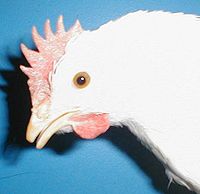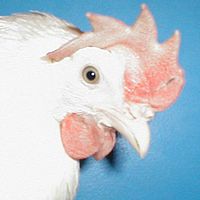- Debeaking
-
Debeaking, also called beak-trimming is the partial removal of the beak of poultry, especially layer hens and turkeys although it may also be practiced on quail and ducks. Most commonly, the beak is shortened permanently, although regrowth can occur. The trimmed lower beak is somewhat longer than the upper beak. USA's UEP guidelines suggest that in egg laying strains of chickens, the length of the upper beak distal from the nostrils which remains following trimming, should be 2 to 3 mm.[1] In the UK, the Farm Animal Welfare Council stated "The accepted procedure is to remove not more than one third of the upper and lower beaks or not more than one third of the upper beak only" but then went on to recommend “Where beak trimming is carried out, it should, wherever possible, be restricted to beak tipping; that is the blunting of the beak to remove the sharp point which can be the cause of the most severe damage to other birds.”[2] The term “debeaking” implies that the entire beak is removed during the trimming process, though in reality only half or less of the beak is removed.[3]
In some countries, such as the United States, beak-trimming is common in egg-laying strains of chickens and turkeys, although in the UK, 90% of turkeys are not beak-trimmed.[4] Beak-trimming is a preventive measure to reduce damage caused by injurious pecking such as cannibalism, feather pecking and vent pecking, and thereby improve livability.[5] However, commercial broiler chickens are not routinely beak trimmed due to their docile nature. In some countries, beak trimming is done as a last resort where alternatives are considered not to be possible or appropriate. Beak-trimming has been banned in Switzerland since 1992.
In close confinement, cannibalism, feather pecking and aggression are common among turkeys, ducks, pheasants, quail, and egg laying strains of chickens of many breeds (including both heritage breeds and modern hybrids). The tendency to cannibalism and feather pecking varies among different strains of chickens, but does not manifest itself consistently. Some flocks of the same breed may be entirely free from cannibalism, while others, under the same management, may have a serious outbreak.
Mortalities mainly due to cannibalism can be up to 15% in egg laying flocks housed in aviaries,[6] straw yards,[7] and free-range systems.[8] Because egg laying strains of chickens can be kept in smaller group sizes in caged systems, cannibalism is reduced [9] leading to a lowered trend in mortality as compared to non-cage systems.[10] Cannibalism among flocks is highly variable and when it is not problematic, then mortalities among production systems are similar.[11]
Contents
History
Beak-trimming was developed at the Ohio Experiment Station in the 1930s.[12] The original form was temporary, cutting roughly 1/4" off the beak. It was thought that the tip of the beak had no blood supply and presumably no sensation. The procedure was performed by hand with a sharp knife, either when deaths due to cannibalism became excessive, or when the problem was anticipated because of a history of cannibalism in the particular strain of chicken.
Cannibalism is a serious management problem dating back to the periods before intensive housing of poultry became popular. Poultry books written before vertical integration of the poultry industry describe the vices of poultry:
Chicks and adult birds' picking at each other until blood shows and then destroying one another by further picking is a source of great loss in many flocks, especially when kept in confinement .... The recommendation of the Ohio Experiment Station of cutting back the tip of the upper beak has been found to be effective until the beak grows out again.[13]
Cannibalism has two peaks in the life of a chicken; during the brooding period and at the onset of egg laying. The point-of-lay cannibalism is generally the most damaging and gets most of the attention. The temporary beak-trimming developed at the Ohio Experiment Station assumed that cannibalism was a phase, and that blunting the beak temporarily would be adequate.
Current methods (2011)
In recent years, the aim has been to develop more permanent beak-trimming (although repeat trimming may be required), using electrically heated blades in a beak-trimming machine, to provide a self-cauterizing cut. There are currently (2011) four widely used methods of beak-trimming: hot blade, cold blade (including scissors or secateurs), electrical (the Bio-beaker) and infrared. The latter two methods usually remove only the tip of the beak and do not leave an open wound, therefore they may offer improvements in welfare. Other approaches such as the use of lasers, freeze drying and chemical retardation have been investigated but are not in widespread use.[14] The infrared method directs a strong source of heat into the inner tissue of the beak and after a few weeks, the tip of the upper and lower beak dies and drops off making the beak shorter with blunt tips. The Bio-beaker, which uses an electric current to burn a small hole in the upper beak, is the preferred method for trimming the beaks of turkeys.[3] The Farm Animal Welfare Council (FAWC) wrote regarding beak-trimming of turkeys that cold cutting was the most accurate method, but that substantial re-growth of the beak occurred; although the Bio-beaker limited beak re-growth, it was less accurate; and that the hot cut was the most distressing procedure for the turkeys.[4]
In the UK, beak-trimming of layer hens normally occurs at 1-day of age as the chick is being sexed and vaccinated.
Pros and cons of beak-trimming
The pros and cons of the most common method of controlling cannibalism, beak-trimming, are well documented. The disadvantages include acute stress and short-term and often times long-term pain following a beak trim. A bird’s ability to consume feed is impaired following beak-trimming because of the new beak shape and pain. The welfare advantages include reduced pecking, feather pulling, and cannibalism (often related to intensive rearing), and decreased mortality prior to slaughter. The welfare disadvantages include increased pain, inability to eat, and stress.[5]
The pain of beak-trimming
Often times, chicks are either debeaked with the use of a heated blade, in which the beak is seared off, or by radiation in which portions of the beak simply fall off. Both methods cause extreme pain, as they are done without the use of anesthesia.The beak contains nociceptors that sense pain and noxious stimuli.[15] Beak trimming excites nociceptors. Following a cut, the nociceptors in the beak stump show abnormal patterns of neural discharge, which indicates acute pain.[16] Neuromas, a tangled mass of swollen regenerating axon sprouts, are found in the healed stumps of birds beak trimmed at 5 weeks of age or older and in birds whose beaks are subjected to severe trimming.[17] During healing, neuromas are formed as part of the normal regeneration process. Eventually, the nerve fibers regrow, the excess axon sprouts regress, and the neuromas disappear. If beak trimming is severe because of improper procedure or done in older birds, the neuromas will persist, and the emitted action potentials are abnormal,[18] which suggest that beak trimmed older birds experience chronic pain.
Alternatives to beak trimming
A range of options have been proposed as possible alternatives to beak trimming including modifying the genetics of domesticated poultry to reduce cannibalistic tendencies. For confined housing where light control is possible, lowering light intensity so that birds cannot see each other as easily reduces antagonistic encounters and aggressive behaviour. Enrichment devices, introduced at an early age, as simple objects hung in a habitat can reduce aggressive behavior. Dividing the population into smaller group sizes reduces cannibalism. Proper body weight management that avoids underweight pullets reduces the probability of underweight pullets with uterine prolapse that leads to cloacal cannibalism.[3]
Footnotes
- ^ United Egg Producers Animal Husbandry Guidelines for U.S. Egg Laying Flocks, 2008
- ^ "FAWC opinion on beak trimming, 2007". http://www.fawc.org.uk/pdf/beak-trimming.pdf. Retrieved 11 November 2011.
- ^ a b c Glatz, 2005
- ^ a b [1]
- ^ a b Hester and Shea-Moore, 2003
- ^ Hill, 1986
- ^ Gibson et al., 1988
- ^ Keeling et al., 1988)
- ^ Appleby and Hughes, 1991; Abrahamsson and Tauson, 1995
- ^ Tauson et al., 2006
- ^ Appleby and Hughes, 1991
- ^ Kennard, 1937
- ^ Jull, 1938
- ^ "AVMA beaktrimming". http://www.avma.org/reference/backgrounders/beak_trimming_bgnd.pdf. Retrieved 11 November 2011.
- ^ Breward, 1984; Gentle, 1992
- ^ Breward, 1984; 1985; Gentle, 1986
- ^ Lunam et al., 1996
- ^ Devour and Rappaport, 1990
References
- Appleby, M. C., and B. O. Hughes (1991) Welfare of laying hens in cages and alternative systems: Environmental, physical and behavioural aspects World's Poultry Science Journal 47:109-128.
- Breward, J. (1984) Cutaneous nociceptors in the chicken beak Proceedings of the Journal of Physiology London 346: 56P.
- Breward, J. (1985) An electrophysiological investigation of the effects of beak trimming in the domestic fowl (Gallus gallus domesticus) Ph.D. thesis, University of Edinburgh.
- Devor, M., and Rappaport, Z.H. (1990) Pain Syndromes in Neurol., edited by H. L. Fields, Butterworths, London, p. 47.
- Gentle, M.J. (1986) Beak trimming in poultry World’s Poultry Science Journal 42: 268-275.
- Gentle, M.J. (1992) Pain in birds Animal Welfare 1:235-247.
- Gentle, M.J., Hughes, B.O., Fox, A. and Waddington, D. (1997) Behavioural and anatomical consequences of two beak trimming methods in 1- and 10-d-old domestic chicks British Poultry Science 38: 453-463.
- Gibson, S.W., P. Dun, and B.O. Hughes (1988). The performance and behaviour of laying fowls in a covered strawyard system Research and Development in Agriculture 5:153-163.
- Glatz, P.C. (2005) Poultry Welfare Issues: Beak Trimming Nottingham University Press, Nottingham, United Kingdom.
- Hester, P.Y. and Shea-Moore, M. (2003) Beak trimming egg-laying strains of chickens World’s Poultry Science Journal 59:458-474.
- Hill, J.A. (1986) Egg production in alternative systems - a review of recent research in the UK Research and Development in Agriculture 3:13-18.
- Jull, M.A. (1938) Poultry Husbandry, 2nd Edition. McGraw Hill, New York., page 346.
- Keeling, L.J., B.O. Hughes, and P. Dun (1988) Performance of free range laying hens in a polythene house and their behaviour on range Farm Building Progress. 94:21-28.
- Kennard, D.C. (1937). Chicken vices Bimonthly Bullentin. 184. Ohio Agricultural Experiment Station. 22:33-39.
- Kuenzel, W.J. (2007) Neurobiological basis of sensory perception: Welfare implications of beak trimming Poultry Science 86:1273-1282.
- Lunam, C.A., Glatz, P.C. and Hsu, Y-J. (1996) The absence of neuromas in beaks of adult hens after conservative trimming at hatch Australian Veterinary Journal 74:46-49.
External links
- Rural Industries Research & Development Corporation - Dr. Phillip C. Glatz' study (2000)
- Do Hens Suffer In Battery Cages? - Dr. Michael C. Appleby's study (1991)
- United Poultry Concerns - opponent of debeaking
- Information on debeaking of ducks
- Why do chickens peck each other?
- Farm Animal Welfare Council - Opinion on Beak Trimming of Laying Hens
Categories:- Poultry farming
- Animal cruelty
- Animal rights
Wikimedia Foundation. 2010.



